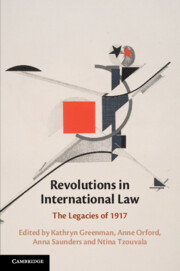Book contents
- Revolutions in International Law
- Revolutions in International Law
- Copyright page
- Contents
- Notes on Contributors
- Acknowledgements
- 1 International Law and Revolution
- Part I Imperialism
- Part II Institutions and Orders
- Part III Intervention
- Part IV Investment
- 11 1917
- 12 1917 and Its Implications for the Law of Expropriation
- 13 Contestations over Legal Authority
- 14 The Mexican Revolution
- Part V Rights
- Index
11 - 1917
Property, Revolution and Rejection in International Law
from Part IV - Investment
Published online by Cambridge University Press: 21 January 2021
- Revolutions in International Law
- Revolutions in International Law
- Copyright page
- Contents
- Notes on Contributors
- Acknowledgements
- 1 International Law and Revolution
- Part I Imperialism
- Part II Institutions and Orders
- Part III Intervention
- Part IV Investment
- 11 1917
- 12 1917 and Its Implications for the Law of Expropriation
- 13 Contestations over Legal Authority
- 14 The Mexican Revolution
- Part V Rights
- Index
Summary
It is well appreciated that legal systems are imbued with patterns. Given their constructed nature, use of precedent, application of principles and multitude of law-making instruments, it is unsurprising that links, repetition, practices and relationships are identified within and across legal systems; and international law is no different in that respect. As a field, it has developed at various points in line with a range of patterns as it responds to particular propositions, assertions, circumstances, events or challenges. And as it has fractured and subdivided into specialist areas, that process has been replicated, each sector of international law producing its own distinct reiterations. Clearly not the sole pattern – but certainly an especially potent one – is the centrality of property and commerce.1 When the history of international law is examined, a repeated process of right-construction can be observed and we can see that mechanisms and artificial constructs have repeatedly been developed to place property and commerce at the centre of international law. Concepts, treaties, arbitrations, even the use of language as a mechanism were all new devices, each responding to contemporary needs with a new construct: ostensibly a break or change of direction but always actually preserving core, central principles, supporting a private-rights focus in rules for international application, creating overall a continuity of approach.
Keywords
- Type
- Chapter
- Information
- Revolutions in International LawThe Legacies of 1917, pp. 271 - 290Publisher: Cambridge University PressPrint publication year: 2021



